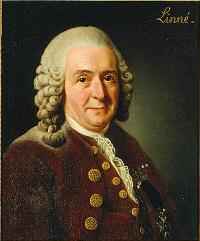Carolus (Carl) Linnaeus (Carl von Linné) (1707 - 1778) - a brief biography
The information below is derived from many sources; major reference texts are listed at the foot of the page.
Swedish naturalist Carl Linnaeus established the binomial system of naming living organisms, setting a format and a structured process for - Classifying the interrelationships between plants (among which he included all fungi), and between animals. The binomial system that Linnaeus devised enables an author to refer to a species confident that it will mean the same thing to informed readers anywhere else in the world.
This painting of Carl Linnaeus is by the German artist Alexander Roslin (1718-1793) - public domain image.
When a new species is discovered and described, its place in the - Classification structure is defined by a two-part (Genus - species) name, such as Amanita muscaria. Rather than use the native language of the discoverer, it has been common practice to use Latin or Greek words as the basis of names. (Recently other word forms have been deemed acceptable.) Many plant, animal and fungi species have been renamed, some several times, as we have learned more about their physical characteristics, behaviour and chemistry and so revised our views of their positions within the hierarchy of - Classification, but the Linnaean binomial system remains unchallenged after more than a quarter of a millennium. (With DNA analysis techniques, scientists have now recategorised many species based upon their most probable relationships on a cladistic tree rather than one base on morphology - evolutionary closeness rather than physical similarity - although often the two methods are not seriously in conflict.)
Linnaeus did a lot more than invent a naming convention, and even today there are many fungi (our interest here) that still carry species names given to them by Linnaeus. For more on the way species names are linked to their original naming-describing authorities in mycological literature see our Citation of Mycology Authorities page...
Carl Linnaeus was born on 23rd May 1707 in Råshult, Sweden. He was the first of five children born to Nils and Christina Linnaeus. Linnaeus was introduced to botany by his father, a Lutheran pastor who had a great love of flowers and passed that passion on to his son.Carl spent much of his early years studying plants and tending his own garden. On leaving high school, Linnaeus was persuaded to study medicine, and in 1727 he entered the University of Lund, but after a year he transferred to Uppsala, Sweden's top university, where he continued his studies. Medicine was based on plants, of course, and so botany was an essential part of any would-be physician's studies. Clearly, botany interested Linnaeus far more than any other subjects in his course did; and eventually, after producing an impressive essay on plant reproduction, he was appointed as a lecturer in botany.
Despite having very little money, in 1728 Linnaeus mounted an expedition to Lappland - a botanical and enthnographical expedition, as it was termed - to study not only the plants but also the people who lived there. From 1732 to 1735 he travelled through Sweden studying the country's natural resources on behalf of the Swedish government. Linnaeus went to the Netherlands in 1735 and finished his medical degree at the University of Harderwijk, immediately enrolling at Leiden University to carry out yet more studies. By this time his ideas about the - Classification of living organisms were becoming clearer, and he published the first edition of Systema Naturae - a slim pamphlet that was to become, via nine further editions through his working life, a multi-volume work. During this time he travelled a great deal between the Netherlands, Germany, France and England, and he had several scientific papers published. Linnaeus returned to practice medicine in Stockholm. There in 1739 he married Sara Lisa Moraea, who bore him six children.
In 1741 Linnaeus became professor of botany at Uppsala University, where he arranged the plants in the University's botanical garden according to his system of - Classification. He made three more botanical expeditions to various parts of Sweden, and most significantly he inspired a generation of students, known as the Linnaeus Apostles, to travel the world and to record both the nature and the culture that they found. (For example see the biographical notes on Adam Afzelius...)
Linnaeus was appointed in 1747 and was knighted in 1758; he then took the name Carl von Linné. He retired in 1776 and died in Uppsala, Sweden, on January 10, 1778.
The abbreviation L. is used to indicate Carl Linnaeus as the author when citing a botanical or mycological name.
Positions and awards
Chief Royal Physician
Major Mycological Works
Observationes Mycologicae (1795 - 1799)
Tentamen Dispositionis Methodicae Fungorum in - Classes, Ordines, Generae et Familias (1797)
Synopsis Methodicae Fungorum (1801)
Mycologia Europaea (1822 - 1828); unfinished work
Selected Sources
http://www.linnaeus.uu.se/online/index-en.html
Blunt, Wilfrid (2004). Linnaeus: the compleat naturalist. London: Frances Lincoln. ISBN 978-0-7112-2362-2.
Lars Hansen, ed. (2007–2011). The Linnaeus Apostles – Global Science & Adventure. 8 vols. 11 books. London & Whitby: The IK Foundation & Company. ISBN 978-1-904145-26-4.
Fascinated by Fungi, 2nd Edition, Pat O'Reilly 2016, reprinted by Coch-y-bonddu Books in 2022.
Fascinated by Fungi. Back by popular demand, Pat O'Reilly's best-selling 450-page hardback book is available now. The latest second edition was republished with a sparkling new cover design in September 2022 by Coch-y-Bonddu Books. Full details and copies are available from the publisher's online bookshop...

